Large format lens

Large format lenses are photographic optics that provide an image circle large enough to cover large format film or plates. Large format lenses are typically used in large format cameras and view cameras.
Photographic optics generally project a circular image behind the lens. On smaller format cameras the image circle generally covers only the intended film size with little room to spare. Large format lenses are an exception. For large format use the circular patch of image light usually extends beyond the minimum size circle needed to fully cover the rectangle of the film. The extra image offers room to spare to make use of camera movements that re-align the lens away from dead center on the film.
Lens designs
Lenses of the same general construction are often given a name implying this design. For example, a Tessar always has four elements in three groups as described below, although Tessars have been produced with different focal lengths and maximum apertures for many decades. Sometimes a name does not identify a specific design; Kodak's Ektar lens brand name encompasses many different types. Sometimes different manufacturers use different names for lenses of the same type; for example the Voigtländer Skopar is of Tessar design. And sometimes identical lenses are sold under different names and at different prices; for example, lenses branded as Rodenstock and Caltar.
Early lenses suffered from flare and low contrast, worsening as the number of lens-air interfaces increased. The introduction of and improvements in anti-reflective coatings vastly reduced flare; some many-element lens designs which had been abandoned due to low contrast in spite of otherwise excellent performance became practical. Lenses designed for use with monochromatic film, first orthochromatic, then panchromatic, had less exacting requirements regarding chromatic aberrations than when colour film is used. When using older lenses today one should check that chromatic aberrations and flare are acceptable for the application.
Wide-angle lens designs
- The Hypergon is a wide angle lens that covers a flat field. It is constructed symmetrically consisting of two deep meniscus elements that almost form a sphere. The aperture is limited to f/20 due to spherical and chromatic aberrations.
- The Topogon is a double Gauss design arranged in a symmetrical design. Due to its wide angle coverage, and the small distortion, it and the Metrogon became the standard aerial lens until it was displaced in 1952.
- The Hologon is a modification of the Biogon lens design. It contains a rear element that is close to film plane for better contrast, but interferes with mirror for SLR. There is significant light falloff at edges, so it is frequently used with ND center graduated filters.
- The Biogon is an ultra-wide-angle design by Ludwig Bertele based on a double-ended reversed-telephoto objective. It was made by Zeiss for their 35mm Contax and the medium-format Hasselblad cameras. The design was physically large, being two focal lengths in length and one focal length in diameter. There are two menisci at the front, and a single strong meniscus element at the rear. The rear element is close to the film plane for low distortion and better contrast, but interferes with the mirror on a single-lens reflex camera.
- The Goerz Dagor has two symmetrical, cemented triplets (6 elements in 2 groups). The two outer elements are positive, one of the inner elements is used to correct spherical aberration, and the other to flatten the field. There are only 4 glass-to-air interfaces, giving better flare and contrast than lenses with more elements, particularly important before the introduction of coated lenses. Reputed to have good sharpness and a large image circle, although there is softness at the edges.
 Hypergon
Hypergon Topogon
Topogon Hologon
Hologon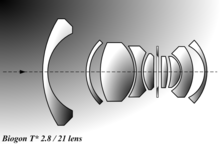 Biogon
Biogon Dagor
Dagor
Normal lens designs
- Anastigmat is an achromatic lens used to reduce or eliminate astigmatism designed specifically for photographic applications. All modern lenses are anastigmatic; lenses produced in the early days when this was a new feature often had the word Anastigmat in their name: Voigtländer Anastigmat Skopar.
- A Tessar comprises four elements in three groups, one positive crown glass element on the front, one negative flint glass element at the center and a negative plano-concave flint glass element cemented with a positive convex crown glass element at the rear. Many manufacturers have produced lenses of this type under their own names.
The Tessar design is suitable for front-element focussing, but unit focussing is used on large format cameras.
- The Heliar design consists of 5 elements in three groups with cemented doublets, allowing correction of spherical, chromatic, and astigmatic aberrations.
- A Planar design is one with 4 groups of 6 elements, and a flat field design. Its symmetrical optical configuration produces low spherical aberration and astigmatism. The design was not widely used until coating processes were available, due to the very low contrast caused by light loss from the large number of transmission surfaces.
- The Sonnar design originally had six elements, later seven, in three groups. The design uses fewer elements than the Planar design and is smaller and less expensive. It has more aberrations but better contrast and less flare than the Planar, a larger maximum aperture and lower chromatic aberration than the Tessar. Large format Sonnars have good sharpness and contrast at large apertures, but are large and heavy, and coverage does not allow much use of movements. The Sonnar has good edge contrast at all apertures, but some softness at wide apertures.
- The Artar is a true apochromatic 4-element in 4 groups symmetrical process lens for the graphic arts, very well corrected for other aberrations. It was designed by Walter Zschokke of Goerz in 1904, based on Emile Von Hoegh's dialyte. If uncoated it is subject to flare due to the 8 air-to-glass surfaces.
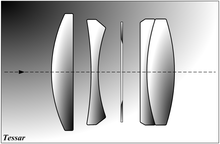 Tessar
Tessar Heliar
Heliar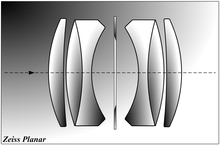 Planar
Planar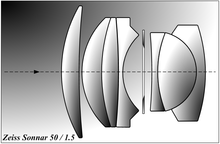 Sonnar
Sonnar Artar
Artar
Telephoto lens designs
A true telephoto lens is designed to require less bellows extension than a long-focus lens of the same focal length.
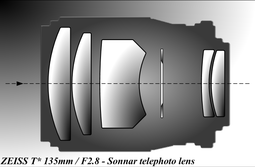 Sonnar telephoto lens.
Sonnar telephoto lens.
See also
References
External links
- Artar lens PDF(de)
- A Short History of the Heliar Lenses
- Large Format: Wide Angle Lens Specifications
- Kerry's Large Format Homepage
- Large Format Lenses: Evaluations By Bjørn Rørslett
- Test Results - Large Format photographic lenses
- Exploring Large Format Camera Technique
- Large-Format Lens Specifications
- How to Mount Large Format Lenses on DSLR Camera